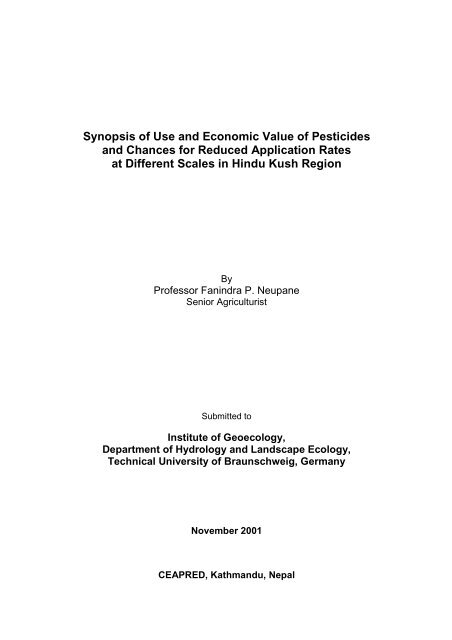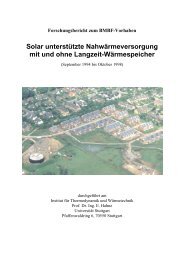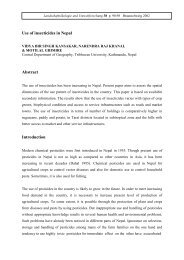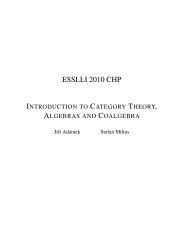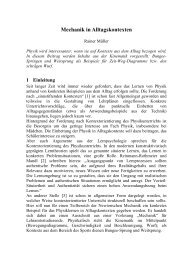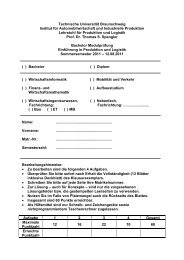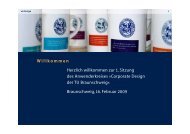Synopsis of Use and Economic Value of Pesticides and Chances for ...
Synopsis of Use and Economic Value of Pesticides and Chances for ...
Synopsis of Use and Economic Value of Pesticides and Chances for ...
You also want an ePaper? Increase the reach of your titles
YUMPU automatically turns print PDFs into web optimized ePapers that Google loves.
<strong>Synopsis</strong> <strong>of</strong> <strong>Use</strong> <strong>and</strong> <strong>Economic</strong> <strong>Value</strong> <strong>of</strong> <strong>Pesticides</strong><br />
<strong>and</strong> <strong>Chances</strong> <strong>for</strong> Reduced Application Rates<br />
at Different Scales in Hindu Kush Region<br />
By<br />
Pr<strong>of</strong>essor Fanindra P. Neupane<br />
Senior Agriculturist<br />
Submitted to<br />
Institute <strong>of</strong> Geoecology,<br />
Department <strong>of</strong> Hydrology <strong>and</strong> L<strong>and</strong>scape Ecology,<br />
Technical University <strong>of</strong> Braunschweig, Germany<br />
November 2001<br />
CEAPRED, Kathm<strong>and</strong>u, Nepal
Table <strong>of</strong> Contents<br />
Page<br />
1. INTRODUCTION 1<br />
2. USE OF PESTICIDES AT DIFFERENT SCALES 1<br />
2.1 Nepal 1<br />
2.1.1 Country Level 1<br />
2.1.2 District Level 4<br />
2.1.3 Village Level 5<br />
2.2 Bangladesh 6<br />
2.3 India 7<br />
2.4 Pakistan 9<br />
2.5 China 9<br />
3. ECONOMIC VALUE OF PESTICIDES 10<br />
4. POSSIBLE REDUCTION OF PESTICIDE APPLICATION RATES 10<br />
4.1 <strong>Use</strong> <strong>of</strong> Alternatives <strong>of</strong> Chemical <strong>Pesticides</strong> 10<br />
4.2 Increase the Level <strong>of</strong> Awareness <strong>of</strong> Farmers <strong>and</strong> General Public 12<br />
4.3 Strengthen Pest <strong>and</strong> Pesticide Research 12<br />
4.4 En<strong>for</strong>cement <strong>of</strong> Pesticide Acts 12<br />
5. CONCLUSION AND RECOMMENDATIONS 12<br />
REFERENCES 14<br />
2
1. INTRODUCTION<br />
The major crops grown in the Hindu Kush Region [(HKR) Afghanistan, Bangladesh, China,<br />
Bhutan, India, Myanmar, Nepal <strong>and</strong> Pakistan] are cereals (rice, wheat, maize, millets, buck<br />
wheat), potato, sugarcane, jute, cotton, grain legumes (chickpea, pigeonpea, black <strong>and</strong><br />
green grams, soybean, French bean etc), fruit crops (mango, banana, litchi, apple, citrus,<br />
papaya, pineapple etc), vegetable crops (crucifers, cucurbits, egg plant, okra etc), oil seed<br />
crops (rape, mustard, sunflower <strong>and</strong> peanut), palms (coconut <strong>and</strong> areca nut), narcotic<br />
plants (tea, c<strong>of</strong>fee <strong>and</strong> tobacco), spices <strong>and</strong> condiments (cardamom, black pepper,<br />
turmeric, ginger, chilli, pepper etc) <strong>and</strong> several others (ICAR, 2000; Neupane, 2001).<br />
These crops suffer from various pests (insects, mites, vertebrates, weeds etc.) <strong>and</strong><br />
diseases (ICAR, 2000; Neupane, 2001a; Shrestha, 1991). Among the various pest control<br />
measures, chemical pesticides have become very popular among the farmers <strong>of</strong> the HKR.<br />
The use <strong>of</strong> these chemicals is rather increasing every year. Similarly, chemical pesticides<br />
are also being used <strong>for</strong> the control <strong>of</strong> human disease vector insects (mosquitoes, flies,<br />
fleas etc).<br />
South <strong>and</strong> Southeast Asian countries consume 26.7 % <strong>of</strong> the pesticides in the world<br />
market. Of this amount, insecticides make up 45.8 %, fungicides 21.9 %, herbicides 29.2<br />
% <strong>and</strong> others 3.1 % (Raheja, 1995). Among the above crops more pesticides are applied<br />
on rice, cotton <strong>and</strong> vegetables.<br />
The use <strong>of</strong> chemical pesticides in agriculture, industry, public places <strong>and</strong> residences has<br />
also created negative impact on human health, wildlife <strong>and</strong> the environment as a whole.<br />
This paper includes the status <strong>of</strong> pesticide use within Nepal <strong>and</strong> some in<strong>for</strong>mation from<br />
Bangladesh <strong>and</strong> India, <strong>and</strong> very little from Pakistan <strong>and</strong> China. In<strong>for</strong>mation from Myanmar<br />
<strong>and</strong> Bhutan could not be found in spite <strong>of</strong> search <strong>for</strong> literature in the local libraries in<br />
Kathm<strong>and</strong>u, Nepal. This paper is a part <strong>of</strong> an agreement between Centre <strong>for</strong><br />
Environmental <strong>and</strong> Agricultural Policy research, Extension <strong>and</strong> Development (CEAPRED),<br />
Nepal, <strong>and</strong> Technical University <strong>of</strong> Braunschweig (TUBS), Germany in 1998, in connection<br />
with a research project entitled “Environmental Risks <strong>of</strong> <strong>Pesticides</strong> <strong>and</strong> Sustainable<br />
Development <strong>of</strong> Integrated Pesticide Management (IPM) <strong>for</strong> Mountain Areas <strong>of</strong> Developing<br />
Countries Considering Socio-economic Conditions <strong>and</strong> Taking Middle Mountains, Central<br />
Nepal as an Example (Develop IPM Nepal)” conducted in Ward No. 4, 5, 6 <strong>and</strong> 9 <strong>of</strong><br />
Panchkhal Village Development Committee <strong>of</strong> Kabhrepalanchok district <strong>of</strong> Nepal.<br />
2. USE OF PESTICIDES AT DIFFERENT SCALES<br />
2.1 Nepal<br />
2.1.1 Country Level<br />
Pesticide use in Nepal started in the early 1950s starting with DDT <strong>for</strong> malaria eradication<br />
(Neupane, 1995). DDT was followed by other organochlorines (BHC, dieldrin, chlordane<br />
etc. <strong>and</strong> organophosphates (ethyl parathion, methyl parathion, malathion, oxydemeton<br />
methyl <strong>and</strong> so on). When the green revolution started in Nepal during the mid-sixties, the<br />
traditional farmers were taught to use agrochemicals specially fertilizers, insecticides <strong>and</strong><br />
fungicides. Now there are 63 registered technical products (27 insecticides, 19 fungicides,<br />
11 herbicides, 1 acaricide, 2 rodenticides, <strong>and</strong> 3 others) available in the market (Table 1)<br />
which are being used on various crops throughout the country (Kansakar 2001).<br />
1
Table 1: Registered <strong>Pesticides</strong> in Nepal<br />
Insecticides Oxydemeton methyl Tridemorph<br />
Acephate Permethrin Validamycin<br />
Alphamethrin Phorate Herbicides<br />
Aluminium phosphide Quinalphos 2,4-D Sodium salt<br />
Azadirachtin Triazophos Anilophos<br />
Bacillus thuringiensis Fungicides Atrazine<br />
Carb<strong>of</strong>uran Benomyl Butachlor<br />
Chlorpyrifos Captan Fluchloralin<br />
Cyfluthrin Carbendazim Glyphosate<br />
Cypermethrin Carboxin Isoproturon<br />
Deltamethrin Thiram Metribuzim<br />
Dichlorvos Copper oxychloride Oxyfluorfen<br />
Dimethoate Copper sulphate Paraquat dichloride<br />
Ensosulfan Dinocap Pendimethalene<br />
Ethion Edifenphos Acadricides<br />
Fenitrothion Kitazin Dic<strong>of</strong>ol<br />
Fenthion Mancozeb Rodenticides<br />
Fenvalerate Metalaxyl Bromadiolone<br />
Lambda-cyhalothrin Metiram Zinc phosphide<br />
Malathion Sulphur Others<br />
Methomyl Thiphonate Alpha naphthyl acetic acid<br />
Methyl prathion Triadimefon Chlormequat chloride<br />
Monocrotophos Tricyclazole Dazomet<br />
Source: Directorate <strong>of</strong> Plant Protection (DOPP) (2001a)<br />
Most <strong>of</strong> the pesticides (98 %) are imported from India. A few are also imported from China.<br />
Very few (2 %) are <strong>for</strong>mulated in Nepal (Man<strong>and</strong>har <strong>and</strong> Palikhe, 1999).<br />
Due to open boarder with India, it is very difficult to control the illegal entry <strong>of</strong> pesticides<br />
into Nepal. As a result the total quantity <strong>of</strong> imported pesticides is unknown. However, the<br />
import figures <strong>for</strong> the year 2000 have been presented in Table 2.<br />
Table 2: Imported <strong>Pesticides</strong> (Technical Products), 2000<br />
<strong>Pesticides</strong><br />
Quantity (Mt)<br />
Fungicides 54.5<br />
Insecticides 47.0<br />
Rodenticides 4.0<br />
Herbicides 2.6<br />
Total 108.1<br />
Source: DOPP (2001a)<br />
The consumption <strong>of</strong> pesticides in terms <strong>of</strong> commercial <strong>for</strong>mulation (commercial product)<br />
per unit area is only 142 g/ha (Dahal, 1995) which is perhaps one <strong>of</strong> the lowest in the HKR.<br />
2
On ecological basis, highest average number <strong>of</strong> l<strong>and</strong> holdings use pesticides in Terai (12.6<br />
%) followed by Hills (4.9 %) <strong>and</strong> Mountains (0.7 %) on the following crops: rice, maize,<br />
wheat, potato <strong>and</strong> vegetables (Kanskar et al., 2001). These figures are from the National<br />
Sample Census <strong>of</strong> Agriculture (CBS, 1993) <strong>and</strong> very old by now. Pesticide consumption in<br />
the country has changed a lot during this one-decade period. The largest quantity <strong>of</strong><br />
pesticides is used in rice (40 – 50 %) followed by grain legumes (14 – 20 %), fiber crops<br />
(13 – 15 %), <strong>and</strong> vegetables <strong>and</strong> fruits (10 – 20 %), <strong>and</strong> the use <strong>of</strong> various pesticides has<br />
been found in the following order: insecticides, fungicides, herbicides, rodenticides, others.<br />
Pesticide use pattern on crops is as follows: use after pest outbreak (59 %) followed by<br />
preventive control (39 %) <strong>and</strong> post-harvest control (2 %) (Man<strong>and</strong>har, <strong>and</strong> Palikhe, 1999).<br />
<strong>Pesticides</strong> are marketed by Agriculture Input Corporation (AIC), a government enterprise<br />
which was the main dealer <strong>of</strong> fertilizers, pesticides <strong>and</strong> seed <strong>for</strong> the whole country until<br />
1994 <strong>and</strong> several private wholesalers <strong>and</strong> retailers (Palikhe <strong>and</strong> Mahat, 2001). At the<br />
district <strong>and</strong> village levels, agro-chemicals including pesticides are distributed by some<br />
agricultural cooperatives <strong>and</strong> private agro-veterinary dealers. In Terai districts, some Indian<br />
dealers also illegally distribute pesticides directly to the farmers.<br />
These days there are complains from farmers about the low efficacy <strong>of</strong> various pesticides<br />
they have been using. It has been assumed that the imported pesticides from India as well<br />
as <strong>for</strong>mulated within Nepal are subst<strong>and</strong>ard. There is very limited facility <strong>for</strong> pesticide<br />
analysis in the country (Nepal Environmental Scientific Services, Private Limited,<br />
Thapathali, Kathm<strong>and</strong>u has limited facility). The DOPP has started checking the quality <strong>of</strong><br />
some <strong>of</strong> the common pesticides from the above company.<br />
There has been misuse <strong>of</strong> pesticides resulting into poison cases <strong>and</strong> deaths <strong>of</strong> people<br />
mainly due to ignorance <strong>and</strong> carelessness. The Pesticide Act <strong>and</strong> Regulation (Table 9)<br />
have been introduced about a decade ago (DOPP, 2001). But the government has not<br />
been able to en<strong>for</strong>ce it effectively. Table 3 presents some pesticides that have been<br />
banned in Nepal.<br />
3
Table 3. Restricted <strong>and</strong> Banned <strong>Pesticides</strong> in Nepal<br />
Pesticide<br />
Remarks<br />
Restricted <strong>Pesticides</strong><br />
B<strong>and</strong>iocarb<br />
To be used <strong>for</strong> public health purpose.<br />
Chorpyrihops+ Cypermethrin Not to be used on mustard crop.<br />
Cyfluthrin<br />
To be used <strong>for</strong> public health purpose.<br />
Dichlorvos<br />
To be sold under <strong>of</strong>ficial recommendation <strong>of</strong> APPO.<br />
Et<strong>of</strong>enprox<br />
To be used <strong>for</strong> public health purpose.<br />
Lambda cyhalothrin<br />
To be used <strong>for</strong> public health purpose.<br />
Mehtomyl<br />
To be sold under <strong>of</strong>ficial recommendation <strong>of</strong> APPO.<br />
Methyl parathion<br />
To bTo be sold under <strong>of</strong>ficial recommendation <strong>of</strong> APPO.<br />
Monocrotophos<br />
To bTo be sold under <strong>of</strong>ficial recommendation <strong>of</strong> APPO.<br />
Oxydemeton methyl<br />
To be sold under <strong>of</strong>ficial recommendation <strong>of</strong> APPO.<br />
Permethrin<br />
To be used <strong>for</strong> public health purpose.<br />
Phorate<br />
To be sold under <strong>of</strong>ficial recommendation <strong>of</strong> APPO.<br />
Triazophos<br />
To be sold under <strong>of</strong>ficial recommendation <strong>of</strong> APPO.<br />
Banned <strong>Pesticides</strong><br />
Aldrin<br />
BHC<br />
Chlordane<br />
DDT<br />
Dieldrin<br />
Endrin<br />
Heptachlor<br />
Lindane<br />
Mirex<br />
Organomercury chloride<br />
Phosphamidon<br />
Toxaphene<br />
Source: DOPP (2001a), APPO = Assistant Plant Protection Officer<br />
Nepal has accumulated some 80.4 Mt <strong>of</strong> obsolete pesticides (Table 4) which has posed a serious<br />
problem <strong>for</strong> its safe disposal because there is no expertise in this country.<br />
2.1.2 District Level<br />
Table 4. Obsolete <strong>Pesticides</strong> in Nepal<br />
Pesticide group<br />
Quantity (Mt)<br />
Organochlorines 37.09<br />
Organophosphates 28.62<br />
Organomercury compounds 8.13<br />
Miscellaneous 6.57<br />
Total 80.41<br />
Source: DOPP (2001a)<br />
There are 75 districts in Nepal, <strong>and</strong> each district has one District Agricultural<br />
Development Office (DADO) under the Department <strong>of</strong> Agriculture (DOA), His Majesty's<br />
Government <strong>of</strong> Nepal (HMG/N). Among various agricultural experts, there is one APPO<br />
in this <strong>of</strong>fice who is responsible <strong>for</strong> various plant protection activities in the district<br />
including the responsibilities <strong>of</strong> Plant Protection Inspector (en<strong>for</strong>cing the pesticidal<br />
regulations). At the district level, distribution <strong>of</strong> pesticides is done both by AIC <strong>and</strong><br />
4
private dealers. The example <strong>of</strong> various pesticides being used in Kabhrepalanchok<br />
district have been presented in Table 5.<br />
2.1.3 Village Level<br />
Table 5. <strong>Use</strong> <strong>of</strong> <strong>Pesticides</strong> in Kabhre District, 1999<br />
<strong>Pesticides</strong> Quantity (kg actual ingredient)<br />
District Panchkhal VDC<br />
Insecticides 15536 997<br />
Fungicides 21403 10605<br />
Weedicides 103 115<br />
Rodenticides 189 12<br />
Total 37231 11729<br />
Source: DADO, Dhulikhel, Kabhrepalanchok District.<br />
For village level study, two villages, namely, Tamaghat <strong>and</strong> Tinpiple within Panchkhal<br />
VDC were selected. The IPM project conducted by TUBS was concentrated in these two<br />
villages. The following is a summary <strong>of</strong> the study conducted by CEAPRED (2000):<br />
The major crops grown in these villages are rice, potato, maize, wheat, mustard, tomato,<br />
bitter gourd, chilli, brinjal, beans, gourd, cabbage <strong>and</strong> cauliflower. Almost all farmers<br />
(more than 97 %) use pesticides <strong>for</strong> controlling various pests <strong>and</strong> diseases. The popular<br />
pesticides being used are as follows:<br />
Insecticides: aluminium phosphide, chlorpyriphos, dichlorvos, dimethoate, fenvalerate,<br />
malathion <strong>and</strong> methyl parathion.<br />
Fungicides: Carbendazim, edifenphos, mancozeb <strong>and</strong> metalaxyl.<br />
Almost all farmers (97 – 100 %) use pesticides on various crops be<strong>for</strong>e harvest <strong>and</strong> very<br />
few (6 %) use on stored commodities (grains). The criteria followed by farmers <strong>for</strong><br />
pesticide application are either the presence <strong>of</strong> pest or their damage symptoms or both.<br />
<strong>Pesticides</strong> are very easily available with agricultural cooperatives or dealers in the<br />
neighbouring areas <strong>of</strong> the farming community. Farmers do not get any kind <strong>of</strong> training on<br />
pesticide management.<br />
Very few farmers (6 %) use pesticidal plants such as neem (Azadirachta indica), mugwort<br />
(Aretemisia vulgaris), chilli (Capsicum frutescens), garlic (Allium sativum) <strong>and</strong><br />
tobacco (Nicotiana spp.) <strong>and</strong> cow urine, wood ash <strong>and</strong> soap <strong>for</strong> controlling different<br />
insect pests <strong>and</strong> diseases.<br />
There is excessive (in terms <strong>of</strong> times <strong>of</strong> application <strong>for</strong> a crop <strong>for</strong> its growing season) use<br />
<strong>of</strong> pesticides on potato <strong>and</strong> vegetable crops (Table 6). The certified waiting periods (time<br />
between last application <strong>and</strong> harvest <strong>of</strong> a crop) <strong>for</strong> several pesticides on vegetable crops<br />
have not been followed by the growers. This has created a serious problem <strong>of</strong> illegal<br />
pesticide residues on vegetables sold in the market. However none <strong>of</strong> the pesticides<br />
used is found to exceed the recommended rates.<br />
5
Farmers have very limited knowledge on pesticides <strong>and</strong> their applications such as types<br />
<strong>of</strong> pesticides, their dilution, application, residual effect, expiry dates, precautionary<br />
measures, effect on environment, health hazards, safe disposal <strong>of</strong> empty containers <strong>and</strong><br />
so on. Among male <strong>and</strong> female farmers the latter has low knowledge on the above<br />
areas.<br />
2.2 Bangladesh<br />
Table 6. Frequency <strong>of</strong> Pesticide Application on Various Crops<br />
No. <strong>of</strong> times per crop season<br />
Crop Tamaghat Tinpiple<br />
Insecticide Fungicide Insecticide Fungicide<br />
Rice 2 - 3 1 - 2 2 - 4 2<br />
Maize 1 - - -<br />
Potato 8 - 12 9 6 - 8<br />
Tomato 7 - 15 4 - 11 10 10<br />
Cabbage & Cauliflower 2-4 7 - -<br />
Bittergourd 5 - 13 14 6 - 7 8<br />
Chill <strong>and</strong> Capsicum 5 - 11 8 7 8<br />
Cucumber 2 - 9 12 - -<br />
Brinjal 2 - 9 2 - 4 6 6<br />
Beans 5 5 - -<br />
Mustard - - 2 1<br />
Source: CEAPRED, (2000)<br />
The in<strong>for</strong>mation in this section is based on Iles <strong>and</strong> Maslen (1999). Bangladesh has<br />
registered pesticides comprising <strong>of</strong> some 92 technical products (<strong>for</strong> active ingredients), 121<br />
<strong>for</strong>mulations <strong>and</strong> 245 br<strong>and</strong> names. Of the technical products 7 are acaricides, 24<br />
fungicides, 44 insecticides, 6 rodenticides <strong>and</strong> 11 weedicides. More popular insecticides<br />
are cypermethrin, dichlorvos, malathion, carb<strong>of</strong>uran <strong>and</strong> mancozeb. The quantity <strong>of</strong><br />
pesticides (<strong>for</strong>mulated products) used in 1998 has been reported to be over 11,000 Mt.<br />
About 70 % <strong>of</strong> pesticides are used on rice. Overall, most pesticides sold annually are<br />
inseticides (about 95 %), herbicides (2.4 %), fungicides (1.8 %) <strong>and</strong> rodenticides (0.1 %).<br />
<strong>Pesticides</strong> are used only 2 - 3 times per season on rice. In case <strong>of</strong> vegetables, pesticides<br />
are used 17 - 150 times per season. This is particularly so on high value vegetable crop<br />
like eggplant, potato, country beans, cabbage <strong>and</strong> tomato. Crops are <strong>of</strong>ten harvested<br />
within 12 - 24 hours <strong>of</strong> spraying <strong>and</strong> then sold in the market.<br />
Some <strong>of</strong> the most persistent <strong>and</strong> hazardous pesticides have been banned or restricted<br />
(Table 7).<br />
6
Table 7. Restricted <strong>and</strong> Banned <strong>Pesticides</strong> in Bangladesh<br />
S. N. Pesticide Remarks<br />
Restricted <strong>Pesticides</strong><br />
1. Chlordane Permitted to use against certain soil insects.<br />
2. Dieldrin Permitted to use against certain soil insects.<br />
3. Endosufan Not permitted <strong>for</strong> use on rice <strong>and</strong> tea.<br />
4. Mercuric fungicides Permitted only <strong>for</strong> sugarcane seed treatment.<br />
5. Synthetic pyrethroids Not permitted <strong>for</strong> use on rice <strong>and</strong> tea.<br />
Banned <strong>Pesticides</strong><br />
1. BHC<br />
2. Carbaryl<br />
3. DDT<br />
4. Disulfoton<br />
5. Endrin<br />
6. Ethyl parathion<br />
7. Lindane<br />
8. Methoxychlor<br />
9. Methyl parathion<br />
10. Phorate<br />
11. Telodrin<br />
There are 26 main companies which <strong>for</strong>mulate, distribute or supply pesticides in<br />
Bangladesh. Two <strong>of</strong> them produce only public health <strong>for</strong>mulations <strong>and</strong> eight <strong>of</strong> them<br />
per<strong>for</strong>m more than one <strong>of</strong> these functions. All these companies are also members <strong>of</strong><br />
Bangladesh <strong>Pesticides</strong> Association.<br />
The pesticide legislation <strong>of</strong> Bangladesh has been presented in Table 9.<br />
There are very limited analytical facilities <strong>and</strong> trained staff to adequately address the<br />
dem<strong>and</strong> <strong>for</strong> services in pesticide quality control <strong>and</strong> pesticide residue level monitoring in<br />
water, soil, fish <strong>and</strong> other animals <strong>and</strong> particularly routine monitoring in vegetables <strong>and</strong><br />
other food commodities in different markets.<br />
2.3 India<br />
India has registered 137 pesticides, <strong>of</strong> them, 57 are manufactured within the country<br />
(Raheja, 1995). The expected total dem<strong>and</strong> <strong>of</strong> pesticides <strong>for</strong> the year 2000 was 100000 Mt<br />
(technical grade) <strong>for</strong> agriculture <strong>and</strong> 4400 Mt <strong>for</strong> public health (David, 1992). Among the<br />
pesticides, insecticides are dominant (70 %) in the Indian market. The use <strong>of</strong> herbicides<br />
has been slowly increasing (Raheja, 1995). In the past DDT, BHC <strong>and</strong> malathion were very<br />
popular taking a major market share (55 %); <strong>and</strong> endosulfan <strong>and</strong> methyl parathion also are<br />
popular insecticides. Now DDT has been banned <strong>for</strong> use in agriculture, but is still being<br />
used in public health. BHC has been banned in agriculture as well as in public health. The<br />
restricted <strong>and</strong> banned pesticides in India have been presented in Table 8.<br />
7
Pesticide<br />
Restricted<br />
Aluminium<br />
phosphide<br />
Capatafol<br />
Carbaryl<br />
Dieldrin<br />
Ethylene dibromide<br />
Lindane<br />
Methyl bromide<br />
Methyl parathion<br />
Sodium cyanide<br />
Banned<br />
Aldrin<br />
BHC<br />
Calcium cyanide<br />
Chlordane<br />
Chlorobenzilate<br />
Copper acetoarsenite<br />
DDT<br />
Dibromochloropropane (DDCP)<br />
Endrin<br />
Eghyl parathion<br />
Ethyl mercury chloride<br />
Heptachlor<br />
Menazon<br />
Nitr<strong>of</strong>en<br />
Nichotine sulphate<br />
Paraquuat-di-methyl sulphate<br />
Pentachloronitrobenzene<br />
(PCNB)<br />
Pentachlorophenol (PCB)<br />
Phenyl mercury acetate (PMA)<br />
Sodium methane arsenate<br />
Tetradifon<br />
Toxaphene<br />
Source: PAU (2001)<br />
Table 8. Restricted <strong>and</strong> Banned <strong>Pesticides</strong> in India<br />
Remarks<br />
It is to be sold only to Government undertakings /<br />
organisations <strong>and</strong> to be used under strict<br />
supervision <strong>of</strong> government expert or pest control<br />
operators.<br />
It is to be used only as seed dresser. Its use as<br />
foliar spray is banned.<br />
Not to be sprayed at flowering stage <strong>of</strong> crops.<br />
It is to be restricted <strong>for</strong> locust control in desert<br />
areas.<br />
It is to be used only as a fumigant <strong>for</strong> food grains<br />
through Central Government/State Government<br />
undertakings / Government organizations.<br />
<strong>Use</strong> <strong>of</strong> lindane <strong>for</strong>mulations generating smoke<br />
shall be used <strong>for</strong> indoor insect pests <strong>of</strong> field crops.<br />
Restriction <strong>of</strong> its sale <strong>and</strong> use is similar to that <strong>of</strong><br />
alumimum phosphide.<br />
<strong>Use</strong> is permitted only on those crops where honey<br />
bees are not acting as pollinators.<br />
Its use shall be restricted <strong>for</strong> fumigation <strong>of</strong> cotton<br />
bales by Plant Protection Adviser to the<br />
Government <strong>of</strong> India.<br />
8
The average per hectare consumption <strong>of</strong> pesticides in India was 440 g. (commercial<br />
product) <strong>for</strong> the year 1989/90 (Anomymous, 1991). The status <strong>of</strong> pesticide legislation has<br />
been presented in Table 9.<br />
2.4 Pakistan<br />
In Pakistan only DDT <strong>and</strong> BHC were locally produced, <strong>and</strong> other technical grade materials<br />
were imported until 1988. There were more than 200 <strong>for</strong>mulations available in the market,<br />
dominated by insecticides (91.4 %) (Raheja, 1995). The status <strong>of</strong> pesticide legislation has<br />
been presented in Table 9.<br />
2.5 China<br />
China produces 90 % <strong>of</strong> the pesticides used in the country. It has more than 400<br />
<strong>for</strong>mulations <strong>and</strong> consumes more than 200000 Mt <strong>of</strong> which 70 % are insecticides<br />
(Annonymous, 1991). The status <strong>of</strong> pesticide legislation has been presented in Table 9.<br />
Status <strong>of</strong> Pesticide Regulations<br />
The status <strong>of</strong> pesticide regulations in some <strong>of</strong> the HKR countries has been presented in<br />
Table No. 9.<br />
Table 9. Pesticide Legislation in Some HKH Region Countries<br />
Country<br />
Pesticide<br />
Legislation<br />
Bangladesh <strong>Pesticides</strong><br />
Ordinance, 1971<br />
(amended in 1980<br />
<strong>and</strong> 1983)<br />
China Regulation <strong>for</strong><br />
Pesticide<br />
Registration, 1982<br />
Regulations <strong>for</strong><br />
Sale <strong>and</strong> <strong>Use</strong> <strong>of</strong><br />
<strong>Pesticides</strong>, 1982<br />
India Insecticides Act,<br />
1968 <strong>and</strong><br />
Insecticides<br />
Rules, 1971<br />
Nepal <strong>Pesticides</strong> Act,<br />
1991; <strong>Pesticides</strong><br />
Regulation, 1993<br />
Pakistan Agricultural<br />
<strong>Pesticides</strong><br />
Ordinance, 1971<br />
Agricultural<br />
<strong>Pesticides</strong> Rules,<br />
1983.<br />
Sources: DOPP (2001); Raheja (1995)<br />
Administering<br />
Authority<br />
Pesticide Technical<br />
Advisory Committee<br />
(PTAC), Ministry <strong>of</strong><br />
Agriculture<br />
Evaluation Committee<br />
on Pesticide<br />
Registration, Ministry<br />
<strong>of</strong> Agriculture<br />
Ministry <strong>of</strong> Agriculture<br />
<strong>and</strong> Public Health<br />
Department<br />
Central Insecticides<br />
Board, Ministry <strong>of</strong><br />
Agriculture.<br />
<strong>Pesticides</strong> Board,<br />
Ministry <strong>of</strong> Agriculture<br />
/ Department <strong>of</strong><br />
Agriculture<br />
Agricultural<br />
<strong>Pesticides</strong> Technical<br />
Advisory Committee<br />
(APTAC), Ministry <strong>of</strong><br />
Food <strong>and</strong> Agriculture<br />
Area <strong>of</strong> Control Methods <strong>of</strong> Control<br />
Import <strong>and</strong><br />
manufacturing<br />
Import <strong>and</strong><br />
manufacturing<br />
H<strong>and</strong>ling<br />
use<br />
<strong>and</strong><br />
Import,<br />
manufacturing<br />
<strong>and</strong> sales<br />
Import,<br />
manufacturing<br />
<strong>and</strong> sales<br />
Import <strong>and</strong><br />
manufacturing<br />
Product registration<br />
<strong>and</strong> import licensing<br />
Product<br />
system<br />
registration<br />
Routine inspection<br />
Product registration,<br />
licensing <strong>of</strong> factories,<br />
godowns <strong>and</strong> shops<br />
Product registration,<br />
licensing <strong>of</strong> factories,<br />
godowns <strong>and</strong> shops<br />
Product registration<br />
<strong>and</strong> import licensing<br />
9
3. ECONOMIC VALUE OF PESTICIDES<br />
Crop losses (pre- <strong>and</strong> post - harvest) due to pests (mainly insects, diseases, weeds <strong>and</strong><br />
rodents) in Nepal have been estimated at 20-35% (Shrestha, 2001). In many instances<br />
pest control certainly pays to the farmers. In Nepal farmers manage the weeds manually<br />
while pesticides (mostly synthetic chemicals) are used against obnoxious pests <strong>and</strong><br />
diseases (<strong>for</strong> example late blight <strong>of</strong> potato <strong>and</strong> tomato, rice blast, armyworms etc).<br />
Commercialization <strong>of</strong> <strong>of</strong>f-season vegetables has become very popular in Nepal near the<br />
high way corridors <strong>and</strong> city areas. This has stimulated the growers to use more inputs<br />
(specially chemical fertilizers <strong>and</strong> pesticides). In most cases farmers have been found to<br />
use more pesticides on vegetables. Even then it has been found to be economical. The<br />
following is an example from the IPM research site in Kabhre district (Table 10).<br />
Table 10. <strong>Economic</strong>s <strong>of</strong> Production <strong>of</strong> Potato <strong>and</strong> Tomato at Panchkhal VDC,<br />
Khabrepalanchok District, Nepal, 2000<br />
Particulars<br />
Cost <strong>of</strong> Production<br />
(Rs / ha)<br />
Quantity Produced<br />
(kg / ha)<br />
Potato Tomato Potato Tomato<br />
Cultural practices (ploughing, 68490 23681 124010 21800<br />
weeding, manure application etc.)<br />
Agricultural inputs 276435 56776<br />
Chemical fertilizers 77158 35968<br />
Seed 119071 1901<br />
Organic manure 76206 5704<br />
Irrigation 714 3880<br />
<strong>Pesticides</strong> 3286 3880<br />
Others 0 5444<br />
Total 344925 80457<br />
Calculation <strong>of</strong> Pr<strong>of</strong>it <strong>and</strong> Loss<br />
Potato: 124010 kg X Rs. 10 = Rs. 1240100 – Rs. 344925 = Rs. 895175 (Pr<strong>of</strong>it)<br />
Tomato: 21800 kg X Rs. 15 = Rs. 327000 – Rs. 80457 = Rs. 46543 (Pr<strong>of</strong>it)<br />
Source: CEAPRED, 2001<br />
4. POSSIBLE REDUCTION OF PESTICIDE APPLICATION RATES<br />
The following are some <strong>of</strong> the major areas which could help in the reduction <strong>of</strong> pesticide<br />
application rates in the Hindu Kush region countries.<br />
4.1 <strong>Use</strong> <strong>of</strong> Alternatives <strong>of</strong> Chemical <strong>Pesticides</strong><br />
A. Bio-control Agents<br />
Bio-control agents such as parasitoids (Trichogrammatids, Braconids, Chalcids,<br />
Ichneumonids etc.) <strong>and</strong> preadors (Chrysopa sp.); <strong>and</strong> microbeals (Bacillus<br />
thuringiensis), some nuclerar polyhedrosis viruses <strong>and</strong> a fungus (Trichoderma sp.)<br />
have been used in very limited areas in India (Atwal, 1993). Some <strong>of</strong> these agents are<br />
used in field trials in Nepal (Neupane, 2000).<br />
10
B. Botanical <strong>Pesticides</strong><br />
There are enormous plant species within the HKR which have pesticidal properties. In<br />
the past (be<strong>for</strong>e the discovery <strong>and</strong> use <strong>of</strong> synthetic chemical pesticides) farmers <strong>of</strong><br />
this region used such plants <strong>for</strong> crop protection. But they have almost been <strong>for</strong>gotten<br />
until now. Now a day some realization has been seen among several workers <strong>of</strong><br />
various countries who have started laboratory <strong>and</strong> field research <strong>and</strong> extension <strong>of</strong> the<br />
use <strong>of</strong> botanical pesticides (Shin Foon, 1984,1987,1989; Schmutterer <strong>and</strong> Ascher,<br />
1984, 1987; Neupane, 2001). Among the various plants having pesticidal properties,<br />
neem (Azadirachta indica) has been found to possess special chemicals (specially<br />
Azadirachtin) that have insecticidal, repelling, antifeeding, growth inhibiting, <strong>and</strong><br />
fungicidal <strong>and</strong> nematicidal properties. The derivatives <strong>of</strong> neem have been widely used<br />
in India (Gahukar, 1995; IARI, 1983; Jotwani <strong>and</strong> Srivastava, 1984) <strong>and</strong> to some<br />
extent in Nepal (Neupane 2001b). Other potential pesticidal plants available in this<br />
region are Malabar nut tree (Justicia adhatoda), custard apple (Annona reticulata),<br />
sugar apple (Annona squamosa), sweet flag (Acorus calamus), goat weed (Ageratum<br />
conyzoides), pyrethrum (Chrysanthemum cineraraefolium), African marigold (Tagetes<br />
erecta), French marigold (Tagetes patula), castor bean (Ricinus communis),<br />
groundnut (Arachis hypogea), derris (Derris elliptica), Chinese yam bean<br />
(Pachyrhizus erosus), ponga oil tree (Pongamia pinnata), ryania (Ryania speciosa),<br />
patchauli (Pogostemon patchouli), chinaberry (Melia azedarach), black pepper (Piper<br />
nigrum), Indian aconite (Aconitum ferox), mowra (Madhuca indica), angel trumpet<br />
(Datura metel), jimsonweed (Datura stramonium), wild tobacco (Nicotiana rustica),<br />
tobacco (Nicotiana tabacum), Indian privet (Vitex negundo), Ginger (Zingiber<br />
<strong>of</strong>ficinale), Toona sureni, Melia toosendan (Ahmed et al., 1984; Shin-Foon, 1984,<br />
1987).<br />
C. Insect Attractants<br />
Insect food lures such as methyl eugenol <strong>and</strong> cue-lure are being used in insect<br />
surveillance against fruit flies, Bactrocera dorsalis <strong>and</strong> B. cucurbitae, respectively, on<br />
fruit crops (mango <strong>and</strong> citrus) <strong>and</strong> gourds (cucurbits) (Neuapane, 2001a).<br />
Commercial use <strong>of</strong> these materials has not yet started in this region.<br />
Some sex lures (pheromones) <strong>of</strong> the following insects have been identified but their<br />
use is very limited: tobacco caterpillar (Spodoptera litura), potato tuber moth<br />
(Phthorimaea operculella), diamondback moth (Plutella xylostella), tomato fruitworm<br />
(Helicoverpa armigera), cutworms (Agrotis ipsilon <strong>and</strong> A. segetum), cotton spotted<br />
bollworms (Earias vittella <strong>and</strong> E. insulana), brinjal furit <strong>and</strong> shoot borer (Leucinodes<br />
orbonalis), grain legume podborer (Maruca vitrata), rice stripped borer (Chilo<br />
suppressalis) <strong>and</strong> maize borer (Chilo partellus).<br />
D. Resistant Crop Varieties<br />
Crop varieties resistant to various insects <strong>and</strong> diseases have been developed <strong>and</strong><br />
widely used in rice, wheat <strong>and</strong> several other crops. Some examples are as follows:<br />
Rice: IR26, IR36, IR42 <strong>and</strong> IR66 against rice brown planthopper (Heinrichs, 1994).<br />
Wheat: RR21, UP262, Nepal 297, BL 1135 against different rusts (AICC, 2001).<br />
Potato: Cardinal against late blight <strong>of</strong> potato (causal organism: Phytopthora<br />
infestans).<br />
11
E. Integrated Pest Management (IPM)<br />
IPM has been started in the HKR countries since several years through DOPP.<br />
However, the impact is not very encouraging. It is mainly due to low emphasis on IPM<br />
from the respective governments. Food <strong>and</strong> Agriculture Organization (FAO) (2000)<br />
has prepared guidelines <strong>for</strong> IPM in some crops, <strong>for</strong> example, vegetables. The DOA <strong>of</strong><br />
HMG/N also has got some assistance from FAO <strong>for</strong> rice <strong>and</strong> vegetable IPM. The<br />
achievements made so far in Nepal are as follows:<br />
HMG/Nepal<br />
a) Season-long (one cropping season) training <strong>of</strong> trainers (<strong>of</strong>ficer level) (No.) : 142<br />
b) Total IPM Farmer Field Schools (No.) : 221<br />
c) Season-long training <strong>of</strong> rice farmers (No.) : 5525<br />
(Source: DOPP)<br />
CEAPRED<br />
a) Season-long training <strong>of</strong> vegetable farmers (No.) : 551<br />
b) Total IPM Farmer Field Schools (No.) : 23<br />
4.2 Increase the Level <strong>of</strong> Awareness <strong>of</strong> Farmers <strong>and</strong> General Public<br />
Majority <strong>of</strong> the farmers in the HKR countries are illiterate. Similarly the general public is<br />
ignorant about the impact <strong>of</strong> pesticides on the environment <strong>and</strong> the human health. Hence<br />
awareness <strong>of</strong> both the farmers as well as the general public should be raised on pesticide<br />
issues.<br />
The plant protection personnel <strong>of</strong> government agencies involved in the field should be<br />
increased both in number as well as quality.<br />
4.3 Strengthen Pest <strong>and</strong> Pesticide Research<br />
There is still a lot to be studied on the bioecology <strong>of</strong> various pests <strong>and</strong> their suppression<br />
methods in the HKR. The manpower involved in this area is limited. Hence, their number<br />
<strong>and</strong> quality needs to be increased.<br />
4.4 En<strong>for</strong>cement <strong>of</strong> Pesticide Acts<br />
Most <strong>of</strong> the countries in the HKR have Pesticide Acts (Table 9). But there are complains<br />
against their poor en<strong>for</strong>cement. Examples can be cited from Nepal <strong>and</strong> India where most<br />
<strong>of</strong> the pesticides belonging to chlorinated hydrocarbons (<strong>for</strong> example, DDT, BHC) have<br />
been banned by law, but these materials are freely available in the market <strong>and</strong> used by the<br />
people. Hence, governments <strong>of</strong> these countries should give proper attention in this area.<br />
5. CONCLUSION AND RECOMMENDATIONS<br />
Significant amount <strong>of</strong> crop loss (in the field as well as storage) occurs every year due to<br />
various pests in the HKR countries. <strong>Pesticides</strong> have been used in this region as a major<br />
weapon to suppress the pests since the green revolution period. They are easily available<br />
at a relatively cheaper price <strong>and</strong> have been found to be economical in most instances.<br />
12
Hence their dem<strong>and</strong> has been ever increasing. <strong>Pesticides</strong> have several drawbacks<br />
(provide negative impact on the environment, wildlife, human being <strong>and</strong> domestic animals)<br />
which have been ignored (mostly unknowingly).<br />
Though these countries have pesticide regulatory acts, their en<strong>for</strong>cement is very loose as<br />
a result there are still several misuse<strong>of</strong> pesticides (<strong>for</strong> example, pesticides <strong>of</strong> chlorinated<br />
hydrocarbon group such as DDT, BHC, though banned in paper, are still in use).<br />
The farmers as well as the majority <strong>of</strong> general public are illiterate in the HKR. The quantity<br />
<strong>and</strong> quality <strong>of</strong> plant protection personnel is minimal <strong>and</strong> hard research in IPM has been<br />
ignored.<br />
On the basis <strong>of</strong> the above observations the following recommendations can be made <strong>for</strong><br />
the HKR countries:<br />
The alternatives to synthetic chemical pesticides (mostly biological means) should be<br />
encouraged <strong>for</strong> pest suppression in agriculture.<br />
The governments should give emphasis on research <strong>and</strong> extension activities related to<br />
IPM.<br />
The pesticide regulations should be en<strong>for</strong>ced properly.<br />
Awareness <strong>of</strong> the farmers <strong>and</strong> consumers should be raised on safe <strong>and</strong> judicious use <strong>of</strong><br />
pesticides.<br />
In<strong>for</strong>mation on pesticides <strong>and</strong> their application should be provided to the farmers in their<br />
native language.<br />
The quality <strong>of</strong> pesticides <strong>and</strong> their residue on marketable products soil <strong>and</strong> water should<br />
be monitored regularly <strong>for</strong> public safety by the concerned governments.<br />
The agricultural extension workers should have proper training in crop protection.<br />
13
REFERENCES<br />
AECC. 2001. Agricultural Diary. Agriculture In<strong>for</strong>mation <strong>and</strong> Communication Centre, Ministry <strong>of</strong><br />
Agriculture <strong>and</strong> Cooperatives, Harihar Bhavan, Pulchowk, Lalitpur, Nepal.<br />
Ahmed, S. M. Grainge, J.W. Hylin, W.C, Mitchel, <strong>and</strong> J. A. Litsinger. 1984. Some promising<br />
plant species <strong>for</strong> use as pest control agents under traditional farming systems, pp. 565-580.<br />
In: Natural <strong>Pesticides</strong> from the Neem Tree <strong>and</strong> Other Tropical Plants (Edited by<br />
Schumutterer, H. <strong>and</strong> K.R. S. Ascher). GTZ Press, Eschborn, Federal Republic <strong>of</strong> Germany.<br />
Anonymous. 1991. Spotlight-pesticide data collection system. RENPAP Gazett 1 (3), 1-51.<br />
(UNDP/UNIDO-Quarterly publication <strong>of</strong> the Regional Network on <strong>Pesticides</strong> in Asia <strong>and</strong> the<br />
Pacific.)<br />
CBS. 1993. National Sample Census <strong>of</strong> Agriculture. Central Bureau <strong>of</strong> Statistics, His Majesty’s<br />
Government <strong>of</strong> Nepal, Kathm<strong>and</strong>u.<br />
CEAPRED. 2000. Baseline Survey <strong>of</strong> <strong>Pesticides</strong> <strong>Use</strong> at Jhikhu Khola Catchment Area. Centre<br />
<strong>for</strong> Environmental <strong>and</strong> Agricultural Policy Research. Extension <strong>and</strong> Development,<br />
Bakhundole, Lalitpur, Nepal.<br />
CEAPRED. 2001. Second <strong>Economic</strong> Survey <strong>of</strong> <strong>Pesticides</strong> <strong>Use</strong> at Jhikhu Khola Catchment Area.<br />
Centre <strong>for</strong> Environmental <strong>and</strong> Agricultural Policy Research. Extension <strong>and</strong> Development,<br />
Bakhundole, Lalitpur, Nepal.<br />
Dahal, L. 1995. A Study on Pesticide Pollution in Nepal. National Conservation Society<br />
Implementation Project, Kathm<strong>and</strong>u, Nepal.<br />
David, B.V. 1992. Pesticide industry in India, pp. 225-233. In: Pest Management <strong>and</strong> <strong>Pesticides</strong>:<br />
Indian Scenario (Edited by David, B.V.), Namrutha Publications, Madras.<br />
FAO. 2000. Tomato Integrated Pest Management: An Ecological Guide. FAO Inter-country<br />
programme <strong>for</strong> the development <strong>and</strong> application <strong>of</strong> Integrated Pest Management in<br />
Vegetable Growing in South & South-East Asia.<br />
FAO. 2000. Cabbage Integrated Pest Management: An Ecological Guide. Ibid.<br />
Gahukar, R.T. 1995. Neem in Plant Protection. Agric Horticultural Publishing House, Nagpur,<br />
India.<br />
Heinrichs, E.A. (ed.). 1994. Biology <strong>and</strong> Management <strong>of</strong> Rice Insects. Wiley Eastern Limited,<br />
New Delhi, India.<br />
ICAR. 2000. H<strong>and</strong>book <strong>of</strong> Agriculture. Indian Council <strong>of</strong> Agricultural Research, New Delhi, India.<br />
Iles, M. <strong>and</strong> R. Maslen. 1999. The Reduction <strong>of</strong> Pesticide Residues in Vegetables in<br />
Bangladesh: Assessment <strong>of</strong> Problems <strong>and</strong> Scope <strong>for</strong> Solutions. Final Report. Natural<br />
Resources Institute, U.K.<br />
Jotwani, M.G. <strong>and</strong> K.P. Srivastava. 1984. A review <strong>of</strong> neem research in India in relation to<br />
insects, pp. 43-56. In: Natural <strong>Pesticides</strong> from the Neem Tree <strong>and</strong> Other Tropical Plants<br />
14
(Edited by H. Schumutterer <strong>and</strong> K.R. S. Ascher). GTZ Press, Eschborn, Fedral Republic <strong>of</strong><br />
Germany.<br />
Kansakar,V.B.S., N.R. Khanal <strong>and</strong> M.L. Ghimire, 2001. <strong>Use</strong> <strong>of</strong> insectidices in Nepal. Paper<br />
presented at the International Workshop Developing Countires, 6-9 November 2001,<br />
Kathm<strong>and</strong>u, Nepal.<br />
Man<strong>and</strong>har, P.P. <strong>and</strong> B.R. Palikhe. 1999. POPs: Current Situation in Nepal. Paper presented at<br />
the Regional Workshop on Management <strong>of</strong> Persistent Organic Pollutants (POPs), 16-19<br />
March 1999, Hanoi, Vietnam.<br />
Neupane, F.P. 1995. Country Pr<strong>of</strong>ile: Agricultural entomology in Nepal. Review <strong>of</strong> Agricultural<br />
Entomology 83 (12): 1291-1304.<br />
Neupane, .P. 2000. Integrated Management <strong>of</strong> Vegetable Insects. Centre <strong>for</strong> Environmental<br />
<strong>and</strong> Agricultural Policy Research, Extension <strong>and</strong> Development, Bakhundol. Lalitpur, Nepal<br />
(in Nepali).<br />
Neupane, F.P. 2002. Crop Pests <strong>and</strong> Their Control, Sajha Prakashan, Pulchowk, Lalitpur, Nepal<br />
(in Nepali).<br />
Neupane, F.P. 2001. Insect Control with Botanicals. Sajha Prakashan, Pulchowk, Lalitpur,<br />
Nepal (in Nepali).<br />
Palikhe, B.M. 2001. Pesticide pollution management in Nepal in harmony with nature. In:<br />
Agriculture <strong>and</strong> Environment. HMG, Ministry <strong>of</strong> Agriculture <strong>and</strong> Cooperatives, Kathm<strong>and</strong>u,<br />
Nepal. pp. 20-27.<br />
PAU. 2001. Package <strong>of</strong> Practices <strong>for</strong> Crops <strong>of</strong> Punjab: Kharif 2001. Punab Agricultural<br />
University (PAU), Ludhiyana, India.<br />
DOPP. 2001a . <strong>Pesticides</strong> Act 1991, <strong>Pesticides</strong> Regulation 1993 <strong>and</strong> Updated List <strong>of</strong> Registered<br />
<strong>Pesticides</strong>. Plant Protection Directorate (DOPP), Department <strong>of</strong> Agriculture, HMG, Nepal. 19<br />
p. (in Nepali).<br />
DOPP. 2001b. Introduction to Plant Protection Program, Achievements <strong>and</strong> Operational<br />
Procedures. Plant Protection Directorate (DOPP), Department <strong>of</strong> Agriculture, HMG, Nepal.<br />
75 p. (in Nepali).<br />
Palikhe, B.R. <strong>and</strong> M.S. Mahat. 2001. Disposal <strong>of</strong> obsolete pesticides: Problems <strong>and</strong> issues in<br />
Nepal. Paper presented at the first Asia Regional Workshop on Obsolete <strong>and</strong> Banned<br />
Pesticide Stocks, 5-8 June 2001. FAO-RAP, Bangkok, Thail<strong>and</strong>.<br />
Raheja, A.K. 1995. Practice <strong>of</strong> IPM in south <strong>and</strong> south east Asia, pp. 69-119. In: Integrated<br />
Pest Management in the Tropics (Edited by A.N. Mengech, K.N. Saxena <strong>and</strong> H.N.B.<br />
Gopalan). John Wiley & Sons, Singapore.<br />
Shrestha, K.K. 1991. Major Diseases <strong>of</strong> Vegetable Crops in Nepal . FAO Fresh Vegetable <strong>and</strong><br />
Seed Project, Vegetable Development Division, Khumaltar, Lalitpur, Nepal (in Nepali).<br />
Shrestha, K.K. 2001. Pesticide Management Program: In View <strong>of</strong> RENAO activities. Paper<br />
presented at the Project Management Committee <strong>and</strong> Tripartite Review Meeting on the<br />
RENPAP, 9-10 July 2000, Nantong, Peoples Republic <strong>of</strong> China.<br />
15
Shin-Foon Chiu. 1987. Experiments on the practical application <strong>of</strong> chinaberry, Melia azedarach,<br />
<strong>and</strong> other naturally occurring insecticides in China, pp. 661-668. In: Natural <strong>Pesticides</strong> from<br />
the Neem Tree <strong>and</strong> Other Tropical Plants (Edited by H. Schumutterer <strong>and</strong> K.R. S. Ascher).<br />
GTZ Press, Eschborn, Federal Republic <strong>of</strong> Germany.<br />
Shin-Foon Chiu. 1984. The active principles <strong>and</strong> insecticidal properties <strong>of</strong> some Chinese plants,<br />
with special reference to Meliaceae, pp. 255-262. Ibid.<br />
Shin-Foon Chiu. 1989. Recent advances in research on botanical insecticides in China, pp. 69-<br />
77. In: Insecticides <strong>of</strong> Plant Origin. (Edited by J.T. Arnason, B.J. R. Philogene, <strong>and</strong> P.<br />
Mor<strong>and</strong>), American Chemical Society, Washington, D.C., USA.<br />
16


